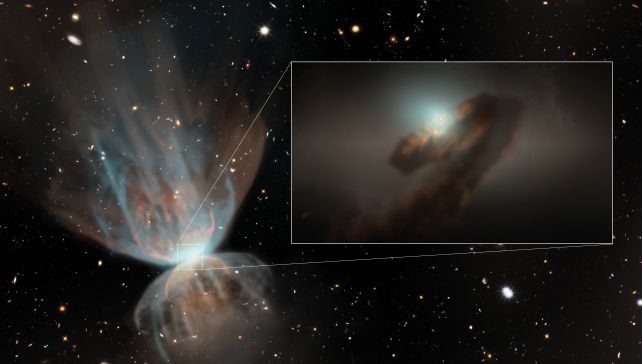Most stars in the Milky Way just hang around doing pretty normal star things, but one particular star just will not.
It's a binary system called FU Orionis, and it's been erupting violently since 1936, when it suddenly, without warning, flared to 1,000 times its usual brightness. This had never been seen before in a young star, and astronomers have been baffled by it for decades.
Now, 88 years later, they finally have answers. FU Orionis is actively feeding on a stream of material – and, using observations from the Atacama Large Millimeter/submillimeter Array, a team of astronomers led by Antonio Hales of the National Radio Astronomy Observatory has directly imaged that stream of material.
"FU Ori has been devouring material for almost 100 years to keep its eruption going. We have finally found an answer to how these young outbursting stars replenish their mass," Hales says. "For the first time we have direct observational evidence of the material fueling the eruptions."

That material is a filament of carbon monoxide, spooling into the central star of the FU Orionis system. That thread contains an insufficient material to fuel the star's outburst, so the researchers think it's the tail end or leftovers of a much larger clump of gas that has been slurped up by the star over time.
"It is possible that the interaction with a bigger stream of gas in the past caused the system to become unstable and trigger the brightness increase," Hales says.
FU Orionis dwells some 1,360 light-years away, in the constellation of Orion. It's a binary system of two relatively small stars, around 2 million years old. Each star is still growing, ringed and fed by a disk of dust and gas that spools into it, slowly feeding its growth at a relatively steady rate.
Although FU Orionis was the first star of its kind observed erupting back in the 1930s, astronomers have since discovered other young, still-growing stars behaving the same way. The mechanism behind FUor stars, as they are known, is thought to be a result of accelerated mass transfer from the accretion disk around each star.
The work of Hales and his colleagues suggests that this might indeed be the case – and that the additional mass comes from material falling from interstellar space onto the disk, giving the baby star a feeding boost that makes it blaze with light and heat.
They took observations using several configurations of the ALMA antennas to image the star system across a range of spatial scales to map the shape and size of the carbon monoxide streamer. Then, they employed numerical modeling to determine the properties, mass, and transfer rate of the streamer to imbue FU Orionis with enough energy to throw a nearly century-long (and counting) tantrum.
"We compared the shape and speed of the observed structure to that expected from a trail of infalling gas, and the numbers made sense," says astronomer Aashish Gupta of the European Southern Observatory.
Where the extra material came from is unclear, but it could be from what remains of the protostellar envelope, the material surrounding the binary as the stars were born, falling onto the disk from the outskirts.
Astronomers believe that all baby stars may undergo similar outburst events; the discovery of what triggered and drove the outburst of FU Orionis, the prototype for erupting baby stars, can help us understand how the process shapes their growth and evolution.
"We have been studying FU Orionis since ALMA's first observations in 2012," Hales says. "It's fascinating to finally have answers."
The research has been published in The Astrophysical Journal.
